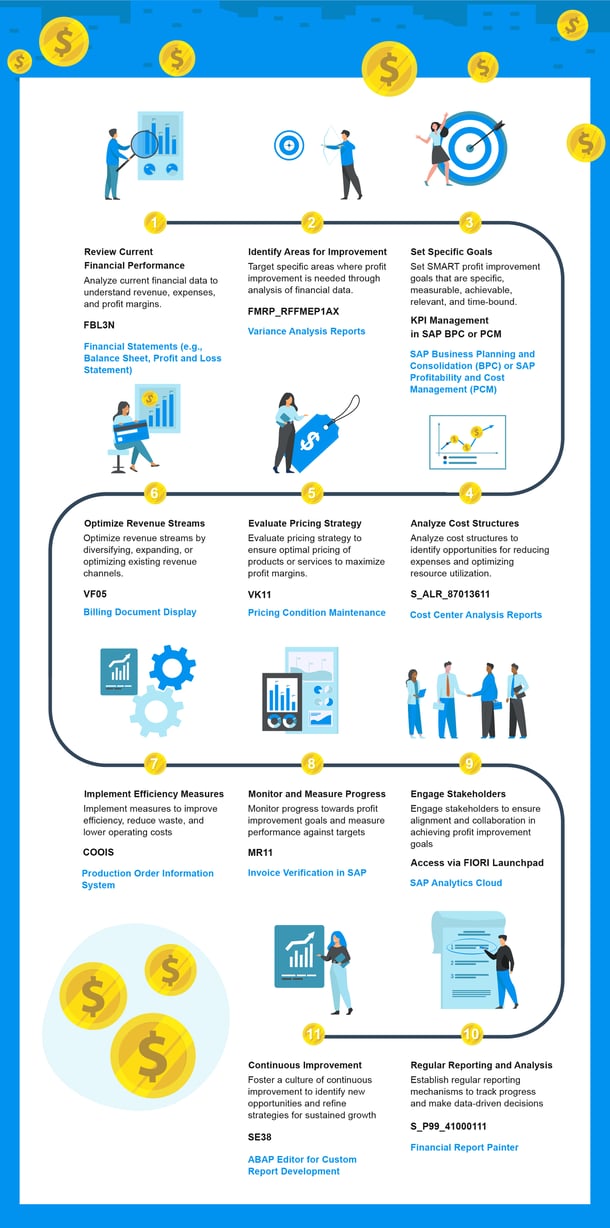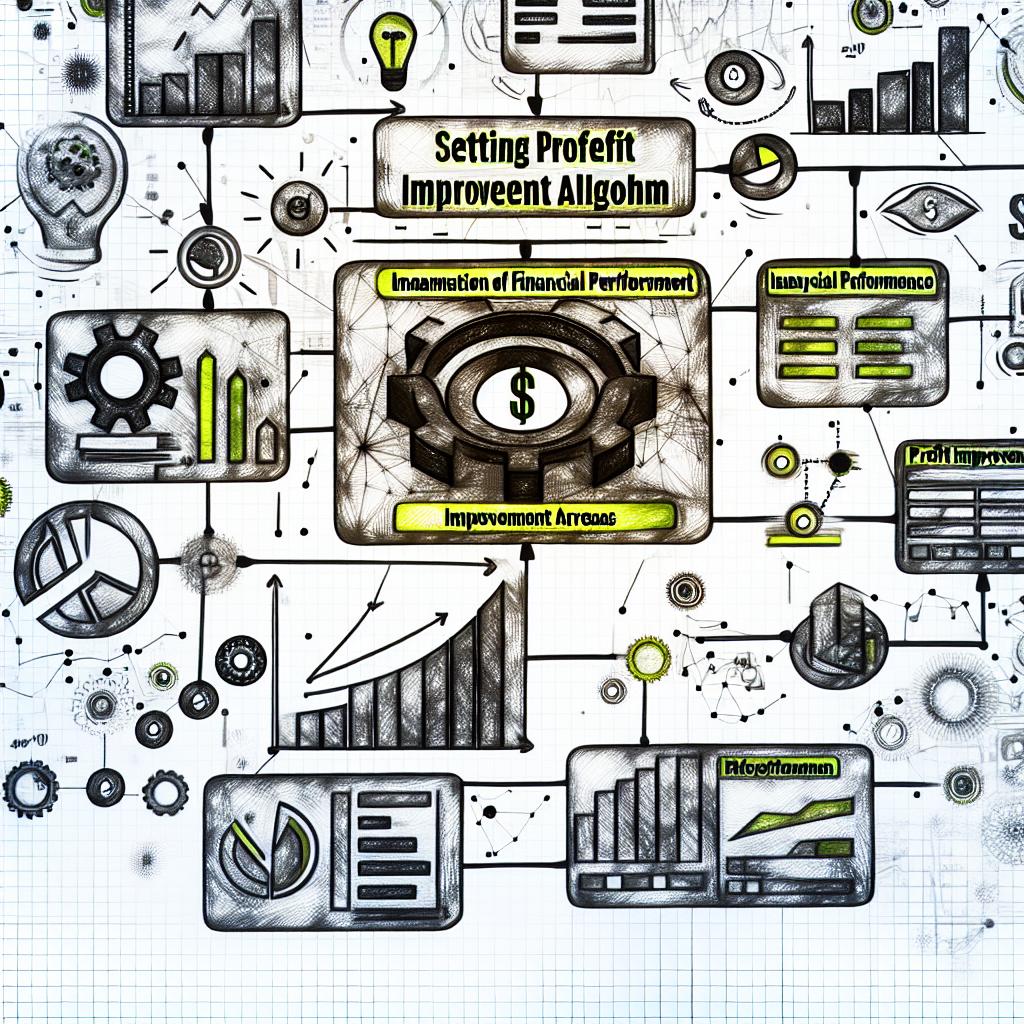Profit Improvement Algorithm Using SAP FICO
Your North Star to Profitability
High Level Profit Improvement Process Using SAP FICO

Your Profit Improvement Plan Roadmap
-
Review Current Financial Performance: Gather data from SAP FICO to analyze your current financial performance. This includes revenue, expenses, profit margins, and any other relevant financial metrics.
You will want to look at your financial statements: Cash Flows (Statement of Cash Flows), Balance Sheet (BS) and most importantly, your Profit and Loss Statement (P&L). In particular, take a look at your Gross Profit Margin. You can't fly a plane without knowing how to read the gauges; the same applies to business. Learn how to read a balance sheet, income statement, and cash flow statement, and you'll be able to participate in conversations about how to set profit goals and ultimately, how to make a profit. -
Identify Areas for Improvement: Utilize SAP FICO data to identify specific areas where profit improvement is needed. This could include reducing expenses, increasing revenue, improving efficiency, or optimizing resource utilization. It might also include focusing on your inventory management practices. In particular, look at your inventory turns.
-
Set Specific Goals: Based on the analysis, set specific, measurable, achievable, relevant, and time-bound (SMART) profit improvement goals. For example, aim to increase net profit margin by 5% within the next fiscal year.
-
Analyze Cost Structures: Use SAP FICO to drill into cost structures and identify areas where costs can be reduced or optimized without sacrificing quality or service.
-
Evaluate Pricing Strategy: Analyze pricing data from SAP FICO to ensure that products or services are priced optimally to maximize profit margins while remaining competitive in the market.
-
Optimize Revenue Streams: Use SAP FICO to evaluate revenue streams and identify opportunities to diversify, expand, or optimize existing revenue channels.
-
Implement Efficiency Measures: Identify inefficiencies in processes or operations through SAP FICO data analysis and implement measures to improve efficiency, reduce waste, and lower operating costs.
-
Monitor and Measure Progress: Continuously monitor and measure progress towards profit improvement goals using SAP FICO. Adjust strategies as needed based on real-time data and performance metrics.
-
Engage Stakeholders: Engage relevant stakeholders, including finance teams, department heads, and executives, to ensure alignment and collaboration in achieving profit improvement goals.
-
Regular Reporting and Analysis: Establish regular reporting mechanisms using SAP FICO to track progress, identify trends, and make data-driven decisions to drive ongoing profit improvement efforts.
-
Continuous Improvement: Foster a culture of continuous improvement within the organization, leveraging SAP FICO insights to identify new opportunities and refine strategies for sustained profit growth.
By integrating SAP FICO into the profit improvement planning and execution process, businesses can leverage real-time financial data and analytics to make informed decisions, optimize performance, and drive sustainable profit growth.
SAP FICO Transaction Codes (T-Codes) or Relevant Reports
To make the Profit Improvement Plan Goal setting process more concrete, I've added in the T-Codes and or SAP Reports you'll need to be able to run to do this.
-
Review Current Financial Performance:
- T-Code: FBL3N - Display/Change Line Items (for reviewing detailed financial transactions)
- Report: Financial Statements (e.g., Balance Sheet, Profit and Loss Statement) generated using T-Codes such as F.01 (Financial Statements) or S_ALR_87012277 (Profit and Loss Statement).
-
Identify Areas for Improvement:
- T-Code: FMRP_RFFMEP1AX - Plan/Actual/Variance Reporting (to compare planned vs. actual figures)
- Report: Variance Analysis Reports (e.g., S_ALR_87012284 - Cost Centers: Actual/Plan/Variance)
-
Set Specific Goals:
- T-Code: KPIs and target settings can be managed using SAP Business Planning and Consolidation (BPC) or SAP Profitability and Cost Management (PCM) modules.
-
Analyze Cost Structures:
- T-Code: S_ALR_87013611 - Cost Center Analysis (to analyze cost center structures)
- Report: Cost Center Reports (e.g., S_ALR_87013678 - Cost Centers: Actual/Plan/Variance)
-
Evaluate Pricing Strategy:
- T-Code: VK11 - Create Condition (for maintaining pricing conditions)
- Report: Pricing Analysis Reports (e.g., VK12 - Display Condition)
-
Optimize Revenue Streams:
- T-Code: VF05 - Display Billing Documents (to analyze sales revenues)
- Report: Revenue Analysis Reports (e.g., S_ALR_87012341 - Sales Revenue: Actual/Plan/Variance)
-
Implement Efficiency Measures:
- T-Code: COOIS - Production Order Information System (for analyzing production efficiency)
- Report: Production Efficiency Reports (e.g., S_ALR_87000132 - Production Order Analysis)
-
Monitor and Measure Progress:
- T-Code: MR11 - Goods Receipt/Invoice Receipt (to manage invoice verification)
- Report: Budget vs. Actual Reports (e.g., S_ALR_87013603 - Budget/Actual/Variance)
-
Engage Stakeholders:
- T-Code: FIORI Launchpad (for accessing SAP applications and reports)
- Tool: SAP Analytics Cloud (for collaborative analytics and reporting)
-
Regular Reporting and Analysis:
- T-Code: S_P99_41000111 - Financial Report Painter (for custom financial reporting)
- Tool: SAP BusinessObjects (for enterprise reporting and analytics)
-
Continuous Improvement:
- T-Code: SE38 - ABAP Editor (for custom report development)
- Tool: SAP Leonardo (for advanced analytics and innovation)
By leveraging these SAP FICO T-Codes, reports, and analytical tools, businesses can effectively manage and optimize their financial performance, drive profit improvement initiatives, and achieve sustainable growth.
Advanced Profit Improvement Goal Setting Practices
Once you have the basics of understanding how your business is doing and using that information to set profit improvement goals, it's time to focus on those activities that likely to move the needle the most.
Business Strategies
If you want to generate higher profit margins, you may need to develop new business strategies. This is where you and your executive team circle back to the basics, starting with Porter's Five Forces and often, implementing the Balanced Scorecard.
Marketing Strategy
There is no universal sales or marketing strategy, so customize yours to fit your product and clientele. We use a combination of Inbound Marketing, Outbound Marketing and Account-Based Marketing. We combine finely honed market research and business acumen to make data-driven decisions and adjust our marketing efforts.
Sales Team
One of the highest profit strategies is to improve the skills of your sales team. That means you must invest in both your sales team members, and your sales systems.
Profitable Customers
Not all customers are created equal. Sadly, some actually are unprofitable and should be fired. Alternatively, some unprofitable customers can become some of your most profitable customers, if you get your offer and delivery dialed-in.
SAP FICO Consulting
The best SAP FICO Consulting providers can not only help you configure your core SAP ERP Financials Solution, they can help you come up with and execute procedures such as setting profit improvement goals, optimizing depreciation schedules, and improved financial closes.
Improve Business Processes
World-class SAP consultants can help you regularly assess your business processes as well as identify areas for improvement. They can help you identify areas where productivity is not up to par, make process improvement recommendations, and ultimately help reconfigure your SAP and other systems to meet your performance standards.
If you need SAP Financial and Controlling consulting support, just click the button to get started.



